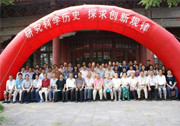| 英文摘要: |
Based on a detailed analysis of the archeological evidence found in Xinjiang since the early 20th century, this paper discusses the weaving technique of jin-silk of the Han to Jin dynasties, and concludes that dihuabenji (the loom with a low pattern draft, operated by one person) was likely more widely used in an earlier period. During the Eastern Han to Jin Dynasties, however, as the weave structure of jin-silk developed and warp count increased, duozongshitihuaji (the loom with many lifting pattern rods or shafts) showed advantages in weaving jin-silk and became the main loom for weaving it. Dihuabenji was relegated to a secondary position then, and was mainly used to weave jin-silk with lower warp count or damask. During the Southern and Northern dynasties, presumably the popularity of the symmetrical repeat pattern in warp direction promoted the development of dihuabenji, and xiaohualouji (the loom furnished with a figure tower) with high pattern draft eventually appeared around the Tang dynasty. Duozongshitihuaji and dihuabenji were not suitable to weave samite (the weft-faced compound). During the Tang dynasty, as the jin-silk declined and samite developed, xiaohualouji was more widely used and became the main loom for patterning. |








